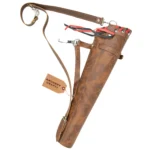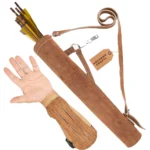Introduction
Archery has evolved for centuries—from traditional field shooting to modern target and 3D competitions. Whether you’re a new archer or a seasoned shooter, understanding quiver types and core archery accessories helps you shoot comfortably, safely, and consistently. In this comprehensive guide, we’ll explore the main gear categories we craft at ArcheryCrafts—back quivers, shoulder quivers, waist/hip quivers, recurve quivers, arm guards, and bow bags—so you can choose the perfect setup for your shooting style.
1. Back Quivers: Classic Carry for Field & 3D
Focus Keyword: Back quiver
Construction: Traditionally worn across the back, our back quivers use durable leather or suede with reinforced seams, smooth liners, and adjustable straps for balanced carry.
Use: Ideal for field, 3D, and traditional archery, where mobility and quick arrow access matter.
Tip: Adjust strap length so arrows sit just behind your drawing shoulder—this reduces shoulder reach and improves draw speed.
Guide: How to Use a Back Quiver Efficiently – Practice a relaxed draw: lean slightly, guide the arrow nock forward with your hand, and keep the fletchings oriented to avoid snagging.
2. Shoulder (Side) Quivers: Versatile & Accessible
Focus Keyword: Shoulder quiver
Construction: A low-profile body worn at the side or across the back; often features multiple tubes or internal dividers for arrow separation.
Use: Great for range practice and target sessions where you want clean arrow organization without bulk.
Tip: Choose a model with a pivoting D-ring or swivel attachment to keep the quiver aligned as you move.
Guide: Mastering Shoulder Quivers – Practice nock-first insertion and keep broadheads protected with caps or dedicated sleeves.
3. Waist/Hip Quivers: Range-Ready Control
Focus Keyword: Waist quiver
Construction: Belt-mounted with angled tubes for quick access; reinforced mouths prevent wear and keep arrows from cutting the lining.
Use: Favored for target archery and range practice where repeatability and rapid arrow retrieval are key.
Tip: Set the angle so arrows don’t rattle when you walk and the nocks present consistently to your draw hand.
Guide: Consistent Draw From a Hip Quiver – Stand square, glance down only with your eyes, not your head; index by feel to maintain form.
4. Recurve Quivers: Purpose-Built for Recurve Shooters
Focus Keyword: Recurve quiver
Construction: Streamlined silhouettes compatible with recurve setups, often featuring pockets for tools, tabs, stringers, and scorecards.
Use: Perfect for Olympic/recurve target shooters who need lightweight carry and organized storage.
Tip: Use pocket organization for essentials (string wax, nock tool, spare tab) to reduce range downtime.
Guide: Recurve Range Setup Essentials – Keep a minimal kit in your quiver: spare nocks, bow stringer, small microfiber cloth, wax.
5. Arm Guards: Form, Comfort & String Protection
Focus Keyword: Arm guard
Construction: Leather or synthetic guards with contoured panels and elastic/strap closures to disperse string impact and protect clothing.
Use: Essential for beginners refining form and experienced archers shooting high-brace or tight sleeves.
Tip: Fit snug but not restrictive. A properly placed arm guard reduces string slap and keeps your release consistent.
Guide: Arm Guard Positioning 101 – Align the guard along the forearm where the string tracks; recheck after every layer change (jacket, hoodie).
6. Bow Bags: Protection for Travel & Storage
Focus Keyword: Bow bag
Construction: Padded shells with soft liners, accessory pockets, and reinforced stitching; options for recurve takedown or one-piece longbows.
Use: Protects limbs, risers, and accessories during transport; keeps dust and moisture away in storage.
Tip: Use internal sleeves for limbs and riser to prevent rub marks; never store wet gear—dry fully first.
Guide: Bow Bag Care – Empty pockets after wet shoots, air out liners, and check zips/straps periodically.
Choosing the Right Archery Gear for You
Purpose: Are you focused on target practice, field/3D, or traditional shooting? Back quivers suit roaming courses; waist/hip quivers shine on static lines.
Skill Level: Beginners benefit from waist/hip quivers and arm guards for easy access and comfort; intermediate/advanced shooters can tailor carry style to form and discipline.
Material: Leather offers longevity and a classic feel; suede gives soft grip and quiet carry; synthetics are lighter and weather-resistant. Choose by climate, maintenance preference, and aesthetic.
Archery Gear Maintenance Tips
Clean Regularly: Wipe leather with a slightly damp cloth; avoid soaking. Remove dust and debris from quiver tubes and pockets.
Store Properly: Keep gear in a cool, dry place. Hang quivers to retain shape; never compress wet leather.
Condition Leather: Apply leather conditioner periodically to prevent drying or cracking. Spot-test first and follow with a soft buff.
Conclusion
From back, shoulder, waist, and recurve quivers to arm guards and bow bags, the right combination elevates comfort, safety, and consistency. Use this guide to match your gear to your discipline and skill level, maintain it well, and shoot with confidence.
Ready to upgrade your setup? Explore premium handcrafted quivers and accessories at ArcheryCrafts.com.



